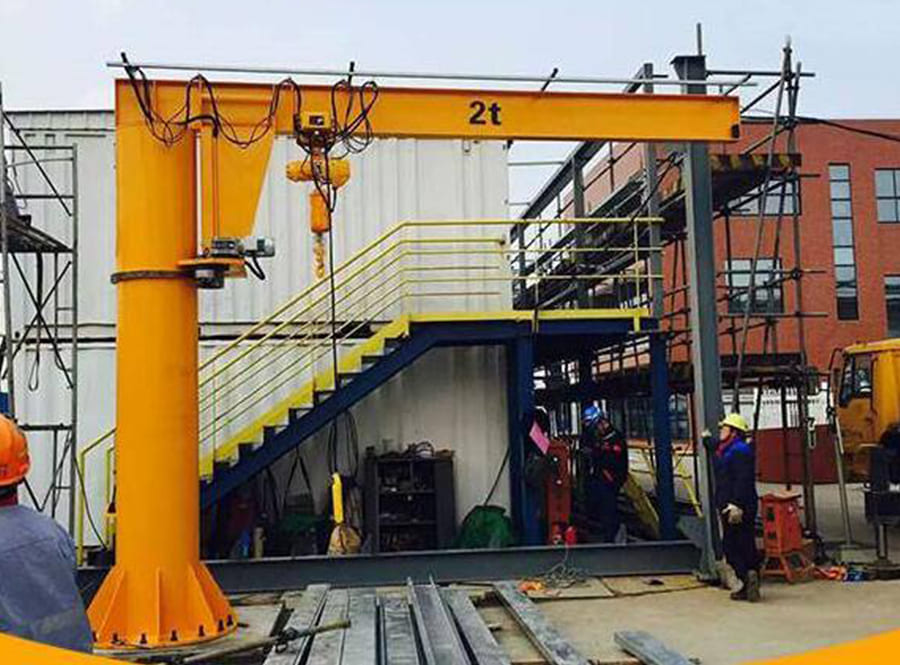A dźwig, znany również jako żuraw obrotowy lub żuraw z wysięgnikiem, to rodzaj sprzętu dźwigowego powszechnie stosowanego w warunkach przemysłowych w celu wydajnego transportu materiałów. Dzięki unikalnej konstrukcji wysięgnika żuraw ten ma kilka zalet i nadaje się do szerokiego zakresu zastosowań.

Struktura i komponenty:
Żuraw składa się z pionowego masztu lub kolumny podtrzymującej poziome ramię wysięgnika. Wysięgnik rozciąga się poziomo, zapewniając zasięg podczas podnoszenia i przenoszenia ładunków. Na końcu wysięgnika znajduje się podnośnik lub mechanizm podnoszący, który umożliwia dźwigowi podnoszenie, opuszczanie i precyzyjne pozycjonowanie obiektów.
Elastyczność i zwrotność:
Jedną z kluczowych zalet żurawia obrotowego jest jego elastyczność i zwrotność. Wysięgnik może obracać się w poziomie, dzięki czemu żuraw może pokryć duży obszar bez konieczności wykonywania rozległych ruchów. Dzięki temu idealnie nadaje się do zastosowań, w których wymagana jest precyzja i zwinność.
Udźwig:
Żurawie obrotowe są dostępne w różnych udźwigach, od modeli lekkich do ciężkich. Udźwig zależy od takich czynników, jak długość i konstrukcja wysięgnika, wytrzymałość zastosowanych materiałów oraz typ zainstalowanego mechanizmu podnoszącego.
Wydajność przestrzenna:
Żurawie obrotowe są znane ze swojej wydajności przestrzennej. Wymagają minimalnej powierzchni w porównaniu do większych systemów suwnic, dzięki czemu nadają się do obiektów o ograniczonej przestrzeni lub nieregularnym układzie. Żurawie obrotowe mogą być montowane na ścianie lub na podłodze, co pozwala na lepsze wykorzystanie dostępnej przestrzeni roboczej.
Wszechstronne zastosowania:
Żurawie obrotowe są szeroko stosowane w branżach takich jak produkcja, magazyny, budownictwo i spedycja. Są powszechnie stosowane do zadań takich jak załadunek/rozładunek ciężarówek, przenoszenie materiałów w obiekcie, montaż maszyn i pozycjonowanie ciężkich komponentów.
Łatwa instalacja i konserwacja:
Żurawie obrotowe są stosunkowo łatwe w montażu i wymagają minimalnych modyfikacji infrastruktury. Można je montować na istniejących kolumnach lub ścianach, co zmniejsza potrzebę stosowania dodatkowych konstrukcji wsporczych. Dodatkowo ich uproszczona konstrukcja i mniejsza liczba ruchomych części przyczyniają się do łatwiejszej konserwacji i skrócenia przestojów.
Funkcje bezpieczeństwa:
Żurawie obrotowe są wyposażone w różne zabezpieczenia zapewniające bezpieczną pracę. Mogą to być urządzenia zabezpieczające przed przeciążeniem, przyciski zatrzymania awaryjnego, wyłączniki krańcowe i systemy antykolizyjne. Regularne przeglądy i konserwacja pomagają utrzymać bezpieczeństwo i niezawodność żurawia.
Opłacalność:
Żurawie obrotowe oferują ekonomiczne rozwiązanie w zakresie podnoszenia, szczególnie w zastosowaniach wymagających okazjonalnych lub lekkich lub umiarkowanych zadań podnoszenia. Ich prostsza konstrukcja i mniejsze wymagania materiałowe sprawiają, że są one tańsze w porównaniu z większymi i bardziej złożonymi systemami dźwigowymi.

Podsumowując, żurawie zapewniają wszechstronne i wydajne rozwiązanie do obsługi materiałów w różnych gałęziach przemysłu. Ich elastyczność, zwrotność, oszczędność miejsca i opłacalność sprawiają, że są popularnym wyborem do zastosowań wymagających precyzyjnych i zwinnych operacji podnoszenia. Dzięki prawidłowej instalacji, konserwacji i przestrzeganiu wytycznych bezpieczeństwa żurawie mogą znacznie zwiększyć produktywność i poprawić efektywność przepływu pracy.
